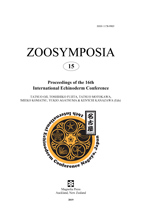Abstract
Sibling competition and developmental asynchrony may greatly influence the arrangement and size of offspring of marine invertebrates that care for their young. In Parvulastra parvivipara, an asterinid sea star that incubates its young in the gonads, sibling cannibalism supports post-metamorphic development. Offspring size varies within (coefficient of variation, CV = 22.6 %) and among (CV = 17.7%) the gonads. Confocal microscopy was used to visualize early embryos and oocytes, and revealed the presence of several developmental stages within individual gonads. The eggs were a mean diameter of 84 μm. The observation of a gastrula at 86 µm smaller than the largest egg observed (134 µm) suggests that terminal egg size varies. The appearance of early embryos surrounded by somatic cells suggests that they may receive nutrients through histotrophy. Sibling competition intensifies once the digestive tract is functional in the tiny juveniles which then start to consume siblings. The arrangement of the offspring in the gonads was observed using micro-computed tomography. The juveniles were oriented with their oral surface facing each other, presumably as a defensive strategy to protect themselves from being eaten. Periodic release of offspring in single or several cohorts indicates continual reproduction. Released and retained juveniles varied in size. It is not known what initiates birth but it may be mediated by sibling competition. Larger adults had a greater allocation to female reproductive output than smaller adults.

